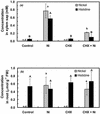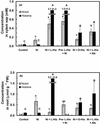The role of free histidine in xylem loading of nickel in Alyssum lesbiacum and Brassica juncea
- PMID: 12586895
- PMCID: PMC166847
- DOI: 10.1104/pp102.010686
The role of free histidine in xylem loading of nickel in Alyssum lesbiacum and Brassica juncea
Abstract
Exposure of the hyperaccumulator Alyssum lesbiacum to nickel (Ni) is known to result in a dose-dependent increase in xylem sap concentrations of Ni and the chelator free histidine (His). Addition of equimolar concentrations of exogenous L-His to an Ni-amended hydroponic rooting medium enhances Ni flux into the xylem in the nonaccumulator Alyssum montanum, and, as reported here, in Brassica juncea L. cv Vitasso. In B. juncea, reducing the entry of L-His into the root by supplying D-His instead of L-His, or L-His in the presence of a 10-fold excess of L-alanine, did not affect root Ni uptake, but reduced Ni release into the xylem. Compared with B. juncea, root His concentrations were constitutively about 4.4-fold higher in A. lesbiacum, and did not increase within 9 h of exposure to Ni. Cycloheximide did not affect root His or Ni concentrations, but strongly decreased the release of His and Ni from the root into the xylem of A. lesbiacum, whereas xylem sap concentrations of Ca and Mg remained unaffected. Near-quantitative chelation of Ni with nitrilotriacetate in the rooting medium did not enhance Ni flux into the xylem of A. lesbiacum and B. juncea, suggesting the absence of a significant apoplastic pathway for Ni entry into the xylem. The data suggest that in B. juncea roots, Ni(2+) uptake is independent of simultaneous uptake of His. In both species, enhanced release of Ni into the xylem is associated with concurrent release of His from an increased root free His pool.
Figures




References
-
- Assuncao AGL, Martins Da Costa P, De Folter S, Vooijs R, Schat H, Aarts MGM. Elevated expression of metal transporter genes in three accessions of the metal hyperaccumulator Thlaspi caerulescens. Plant Cell Environ. 2001;24:217–226.
-
- Baker AJM, Brooks RR. Terrestrial higher plant which hyperaccumulate metallic elements: a review of their distribution, ecology and phytochemistry. Biorecovery. 1989;1:81–126.
-
- Baker AJM, McGrath SP, Reeves RD, Smith JAC. A review of the biological resource for possible exploitation in the phytoremediation of metal-polluted soils. In: Terry N, Bañuelos GS, editors. Phytoremediation of Contaminated Soil and Water. Boca Raton, FL: CRC Press LLC; 1999. pp. 85–107.
-
- Blaylock MJ, Salt DE, Dushenkov S, Zakharova O, Gussman C, Kapulnik Y, Ensley BD, Raskin I. Enhanced accumulation of lead in Indian Mustard by soil-applied chelating agents. Environ Sci Technol. 1997;31:860–865.
-
- Boyd RS. Hyperaccumulation as a plant defensive strategy. In: Brooks RR, editor. Plants that Hyperaccumulate Heavy Metals. New York: CAB International; 1998. pp. 181–201.
Publication types
MeSH terms
Substances
LinkOut - more resources
Full Text Sources
Miscellaneous

